1. Backyard birds have different feeding requirements. Different styles of feeders will attract different and a larger variety of birds to your backyard. These are the basic bird feeders for an all around good backyard bird feeding program:
Seed Tube Bird Feeder: Open port seed tube bird feeders are considered exclusive bird feeders meaning, they exclude many larger birds. These feeders primarily attract a variety of smaller birds. However, when a seed saver tray is added, it will allow larger birds a place to perch and feed.
Exclusive bird feeder. Excludes larger birds. Primarily feeds smaller birds such as chickadees, finch, and nuthatches.
Made from a variety of materials. (PVC, Polycarbonate, steel, acrylic) Most PVC and Polycarbonate tubes carry a lifetime guarantee.
Preferred feed to use is black oil sunflower seed, sunflower hearts, safflower seed, or other nut based mixes.
Easily hung, but can be post mounted.
Seed saver trays can be attached to the bottoms.
A good starter feeder for the backyard
Nyjer Thistle: A very specialized feeder for Nyjer thistle or finch mixes which primarily attracts birds of the finch family such as Goldfinch, House Finch, Purple Finch and Pine Siskin. Indigo Buntings will feed on these feeders if those birds are in your area.
A tube feeder that is designed for feeding Nyjer thistle, a small imported seed.
Attracts goldfinch, house finch, pine siskin, purple finch. Indigo buntings and other finch like birds.
Made from a variety of materials.(PVC, Polycarbonate, steel, acrylic, and wood. PVC and Polycarbonate tubes usually carry a lifetime guarantee.)
Use Nyjer thistle or a quality finch mix.(Best Finch Mix: 50% Nyjer seed and 50% fine sunflower chips.)
Hang thistle feeders near small bushes or trees with lower branches.
Hopper Bird Feeders: This is a good all around feeder for attracting a variety of both large and small backyard feeder birds. It is considered a non-exclusive bird feeder since it does not exclude any birds. If the feeding area is large enough occasionally ground feeding birds will feed on this type of feeder, especially if the ground is covered with snow or ice.
Non-exclusive feeder which attracts both large and small birds.
Storage capacity for holding quantities of feed.
Available in a variety of durable materials. (Cedar, metal, recycled plastic, acrylic)
Recommended feeds: black oil sunflower seed, safflower seed or any nut based mix combination.
Can be hung or post mounted.
Good basic backyard bird feeder.
Platform Bird Feeders: Elevated platform bird feeders are another of the non-exclusive bird feeders. It does not exclude any birds. Large and small birds alike can access it very easily along with some birds that typically feed on the ground.
A non-exclusive bird feeder that is very versatile.
Can be hung or mounted on a pole or post. Some have a roof to protect the seed from inclement weather. Screen or perforated steel or nylon bottoms prevent water from accumulating in the feeder and helps to dry out seed if it becomes wet.
Available in a variety of durable materials. (Cedar, metal, recycled plastic and acrylic)
Recommended feeds: Black oil sunflower seed, safflower seed, sunflower hearts, or any nut based mix combination. Also a good feeder to use with general wild bird mixes.
Excellent bird feeder for peanuts in the shell, meal worms, and fruits.
Ground Feeders: Ground bird feeders are the perfect feeder for ground foraging birds such as native sparrows, juncos and doves. Also attractive to the more opportunistic birds such as Cardinals and Jays. These feeders keep the bird seed off the ground reducing spoilage. Besides being more sanitary for the birds it is also keeps debris off the ground and is easier to dispose of the shells.
Ground feeders are just that, feeders which sit on or near to the ground for ground foraging birds such as mourning doves, native sparrows, Juncos, and towhees.
Screen or perforated bottoms prevent water from standing in the feeder and allows the seed to air dry after rain & snow. Available with or without roofs.
Use safflower seed and white Proso millet in this feeder which will attract a variety of the birds you prefer while deterring squirrels and the Common Grackles. (A good feeder for general wild bird mixes if squirrels are not a problem.)
A variety of other birds will also feed at ground level such as northern cardinals and house finch.
Keeps seed off the ground to prevent spoiling.
Can be located under an existing feeder to catch seeds dropped by birds.
Suet Bird Feeders: Suet bird feeders using either commercial suets, or suet from your local meat market, provide a great source of year round protein. Placed on or near a tree this feeder will attract Nut Hatches, Brown Creepers, Chickadees, and a variety of woodpeckers. Wrens will occasionally feed on the suet as well. Suet is in high demand for these birds during the spring and summer months.
Suet is for the birds of the tree trunk zone.
Commercial suets of 100% rendered beef fat are preferred. There is a large variety of commercial suets which contain various products from seeds and nuts to fruits mixed into 100% tallow.Pure suets, mixtures which do not contain nuts, seed and other products are least attractive to squirrels and European Starlings.
Feed suet year round. Although it provides a great source of energy during the winter months, birds will actually consume more animal protein between March and August during the stresses of nesting and raising their young. Oftentimes woodpeckers will bring their young to the suet feeder once they have fledged the nest.
Up-side down suet feeders will help to reduce Starlings from over-powering the feeder. Suet feeders surrounded by cages will repel Starlings as well as squirrels.
If using a simple hanging wire suet basket, simply leave the hard plastic shell on the suet cake so the suet is only exposed one side. Then hang the basket at a steep angle or directly upside down. If Starlings land on the top they cannot peck through the plastic shell.
2. General wild bird mixes are best placed on or near the ground for ground feeding birds. Reserve elevated feeders for the nuts or nut based mixes. Avoid general bird mixes containing Milo, red millet or wheat. These are filler seeds which bulk up the weight thus lowering the price. While game birds and house sparrows consume these products they are not desired by song birds. Read the label for key ingredients.
3. Thistle seed has an extremely short shelf life of 3 to 5 months. This is the result of heat sterilization of the imported seed by the USDA. This method is used to avoid introducing non-native plants into North America. A newly purchased bag of thistle seed does not guarantee freshness since many merchants may stock large quantities for long periods of time. Songbirds will reject feeders containing old thistle seed is the primary cause in failing to attract birds to a thistle feeder. Inquire about the freshness of the seed you purchase, or purchase from reputable suppliers.
4. To deter squirrels and grackles, use safflower seed by itself in any of the bird feeders with the exception of thistle tube feeders. Safflower seed is attractive to cardinals, house finch, chickadees, doves and other birds, yet grackles rarely feed on it if at all. A feeder filled with safflower seed may be hung in a tree next to a squirrels nest and they will totally ignore it. Make it a part of you feeding program. It may take up to a week for your birds to become accustomed to safflower seed if it has never been offered to them before.
5. Although winter is the traditional bird feeding period, many people have established year round bird feeding programs. Natural foods become scarce after winter until a new crop of seeds and berries ripen in late summer. Wildlife biologists have found that birds nest earlier, quicker, and have more successful nestings when supplemental foods are offered. This is due to less time spent foraging and competing for low food reserves after winter. For example: Woodpeckers during the nesting season eat more suet between March and July than all winter long. You can attract a large variety of birds through-out the year by establishing a year round bird feeding program.
6. Providing a fresh source of water for birds is an important feature during all seasons. Puddles of rain water contain pollutants and toxins that are harmful to birds. In winter, open water is a rare commodity. Searching for water in frigid temperatures can waste precious energy needed to get birds through cold winter nights. And clean feathers provide valuable insulation to help keep them warm. Motion created in water, either by a waterfall or a dripper, attracts high flying birds, and is heard at a great distance.
Blog Archive
-
▼
2012
(26)
-
▼
July
(14)
- The Bald Eagle Apology Project of Alabama
- How to Take Admirable Bird Photos - 5 Digital Phot...
- Feeding Agrarian Birds Responsibly
- You Need Pest Bird Deterrents
- Time to Bird Proof Your Property
- Water Features Attract More Birds to Your Yard
- How to Start Bird Watching
- Using Bird Barriers to Control Pest Birds
- Top 20 Bird and Parrot Related US Vacation Destina...
- Bird Control - It's Not Just For the Birds
- What About the Birds
- It's October and Fall Migration For Wild Birds is ...
- Basic Backyard Bird Feeder Guide - Six Feeders You...
- Top Tips For Successful Bird Watching and Birding
-
▼
July
(14)




































